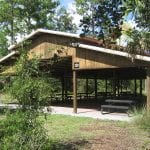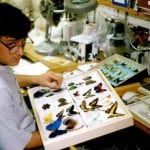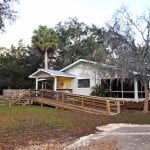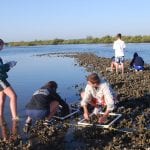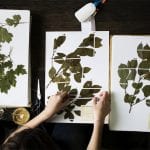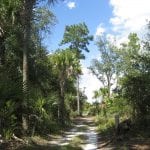The UCF Biology department is home to numerous research labs and facilities accessible to our faculty, post-docs, graduate students, undergraduate students and visiting scientists alike. Although some of these facilities are housed within the biology building proper, many are strategically placed throughout campus, as well as throughout Central Florida. Furthermore, the Department of Biology partners with a variety of extramural entities that enhance our research capabilities, including the Archbold Field Station and Disney’s Wildlife Persevere.
-
-

Arboretum
The Arboretum of The University of Central Florida was founded in 1983. From the original 12-acre “quick view” garden with a mix of ornamental and native plants in the pond pine community adjacent the Stockard Conservatory Greenhouse, The Arboretum has grown to nearly 80 acres. North of the 9 acre man-made lake and the Engineering E-2 parking lot, trails take visitors through a 5-7 acre cypress dome and a picturesque 2-3 acre oak hammock. North of the oak hammock the trail crosses an open area with wild rosemary and sand pine, and oak scrub, returning to the cypress dome. An unmarked trail circles the cypress dome on the north, club mosses and carnivorous sundews lining the sides, before rejoining the main trail on the southwest side of the dome.
Read More

Bug Closet
The University of Central Florida Collection of Arthropods at the University of Central Florida (UCFC), colloquially known as the Bug Closet, is a regionally focused research collection whose core mission is to document the biodiversity of insects and related arthropods in Central Florida. With more than 430,000 specimens in its holdings, most of which have been collected during the past twenty years, UCFC has arguably the best material of recent Central Florida insects, with a heavy emphasis on Hymenoptera (bees and wasps) and Coleoptera (beetles). Moreover, the collection has been databased at specimen-level in its entirety and is available online to the public, providing an invaluable resource to the scientific community.
Read More

Caretta House
In 2016, the University of Central Florida and the US Fish and Wildlife Service entered into a Memorandum of Agreement granting UCF and the Biology Department’s Marine Turtle Research Group use of the Caretta House for coastal sea turtle research activities. Located 70 miles from UCF’s main campus in Orlando, on the Archie Carr National Wildlife Refuge (ACNWR) in Melbourne Beach, Florida, the Caretta House serves as the Marine Turtle Research Group’s sea turtle field station. The Caretta House serves as the MTRG’s home base from which approximately 29 miles of nesting beach are monitored daily or nightly during the summer sea turtle nesting season, including the northernmost 13 miles of the ACNWR. Juvenile sea turtles are monitored semi-monthly in the Indian River Lagoon within the Pelican Island National Wildlife Refuge.
Read More

Econfina River Field Research Station
The Econfina River Field Research Station, located in Econfina River State Park, consists of a research building and as well as researcher accommodations. The research building is a flexible workspace designed to be used for research teams or undergraduate/graduate students to prepare for field work, to process and/or store collected samples, and to serve as an outreach facility for the Department to convey information to park visitors. Located right across the street from the Field Station, is a fully furnished 1100 sq ft condo which can provide accommodations for students and faculty doing research and/or teaching field courses in the Econfina River State Park area.
Read More

Feller’s House
In 2016, the University of Central Florida and the US Fish and Wildlife Service entered into a Memorandum of Agreement granting UCF and the Biology Department’s Marine Turtle Research Group use of the Caretta House for coastal sea turtle research activities. Located 70 miles from UCF’s main campus in Orlando, on the Archie Carr National Wildlife Refuge (ACNWR) in Melbourne Beach, Florida, the Caretta House serves as the Marine Turtle Research Group’s sea turtle field station. The Caretta House serves as the MTRG’s home base from which approximately 29 miles of nesting beach are monitored daily or nightly during the summer sea turtle nesting season, including the northernmost 13 miles of the ACNWR. Juvenile sea turtles are monitored semi-monthly in the Indian River Lagoon within the Pelican Island National Wildlife Refuge.
Read More

Greenhouse
This 6000 sq ft facility consists of one air-conditioned bay, two evaporatively cooled bays, and a headhouse with storage and space for potting and soil processing. The evaporatively cooled bays have automated drip watering systems distributed across six benches, supporting pot-based plant growth. The space is used primarily for research on plant physiology, plant genetics, and plant-microbial relations.
Read More
-

Herbarium
The UCF Herbarium was founded in 1968 for the deposit, curation, and study of preserved plant and fungi specimens. Vascular plants, mosses, liverworts, lichens, fungi and macro-algae can all be found in the collections of the UCF Herbarium. The growing collection includes over 20,000 specimens some dating back to the 1920s.
Read More

Bio-Vehicle Service Center
UCF’s Bio-Vehicles Service Center provides, on a first-come, first-serve basis, a limited number of University-owned vehicles for faculty, staff or volunteers who are conducting official university business. Personal use of motor pool vehicles is prohibited. Students in non-paid status are not covered by the state liability insurance policy and may NOT drive state-owned university vehicles.
Read More

